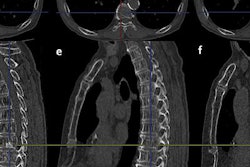CHICAGO - Fluorine-18 (F-18) fluoride ion PET/CT may help predict which metastatic lesions will be painful in the thoracolumbar spine, potentially leading to better preventive treatment for those patients, according to researchers from Stanford University in Stanford, CA.
The study was presented Sunday at the RSNA annual meeting and also received the RSNA Research Trainee Award.
According to the researchers, some 1.4 million people in the U.S. are diagnosed with cancer each year; approximately 10% of those patients will develop spinal metastases later in life.
"These spinal metastases can result in significant morbidity, including debilitating pain and, sometimes, even paralysis," said lead author Dr. Vijay Aroor Rao, chief resident in the department of radiology at Santa Clara Valley Hospital in California and a member of Stanford's Molecular Imaging Program. "In fact, pain related to bony metastases is the most significant morbid experience reported by patients suffering from cancer."
Study objectives
Given F-18 fluoride PET/CT's ability to detect bony metastases, researchers sought to determine if there is a relationship between the extent of F-18 fluoride uptake (SUV) in the thoracolumbar spine and the presence of direct back pain in patients with metastatic disease.
The researchers retrospectively reviewed 15 patients (11 men, four women) between 19 and 81 years of age, with an average age of 57 years. All 15 patients had received whole-body sodium fluoride FDG-PET/CT scans at the same institution.
The same 15 patients also received an FDG-PET/CT scan with an average interval of 6.3 days, ranging from one to 28 days, between imaging studies.
Among the 15 cases, nine patients (60%) had received chemotherapy at the time of imaging, and three patients (20%) had received no chemotherapy or had received it several months before imaging. There was no information on whether the three remaining patients had received chemotherapy.
Patient groups
The 15 patients were divided into three categories: patients with both thoracolumbar metastatic disease and back pain; patients with thoracolumbar metastatic disease and no back pain; and patients with a primary neoplasm, no spine metastases, and no back pain.
The researchers calculated mean SUVs in patients in the first two categories to determine the level of disease in the entire thoracolumbar spine and noted the highest SUV for each patient for both FDG-PET/CT and F-18 fluoride PET/CT scans.
"We found that patients with painful metastases have statistically significant increased uptake of F-18 fluoride, compared to the other two categories," Rao said.
In the F-18 fluoride comparison, patients with painful spine metastases had the highest mean SUV at 27.7, while patients with nonpainful spine metastases had the second highest mean SUV at 11.4. Patients with no back pain and no spine metastases had the lowest mean SUV at 7.9.
In the FDG-PET/CT results, patients with painful spine metastases still had the highest mean SUV at 7.9, but researchers concluded there was no statistically significant difference in uptake when compared to the other two patient groups' mean SUVs of 2.9 and 3.9, respectively.
"One possibility [for the FDG-PET/CT similarities] could be that painful metastases may have the same degree of glucose metabolism compared to nonpainful metastases," Rao said.
Study limitations
Rao cited several limitations of the study, including the small number of patients who have been scanned by sodium fluoride PET, which made for a small retrospective sample. In addition, the time interval between chemotherapy and imaging varied among the patients, which can be a confounding variable.
Despite the limitations, the researchers concluded that F-18 fluoride uptake is abundant in painful metastatic lesions compared to nonpainful lesions of the thoracolumbar spinal canal in patients with back pain.
"Our hopes are that with further research, this threshold SUV for determining if metastases will be painful or not can be ascertained," Rao said. "At that point, all patients with spine metastases can undergo F-18 fluoride PET/CT and be stratified into two groups -- those who are low risk and those at high risk for developing painful metastases."
Clinical benefits
Patients in the high-risk category can be "treated pre-emptively or more aggressively, and perhaps the pain may be prevented completely to improve the quality of life for tens of thousands of people," Rao concluded.
At the end of the presentation, Rao received the RSNA Research Trainee Award from Dr. Milton Guiberteau, chairman of the RSNA nuclear medicine subcommittee.
Guiberteau serves as academic chief in the department of medical imaging/radiology and division chief of nuclear medicine at St. Joseph Medical Center in Houston. He also is a professor of clinical radiology at the University of Texas Medical School in Houston.
By Wayne Forrest
AuntMinnie.com staff writer
November 29, 2009
Related Reading
Early FDG-PET/CT may help head and neck cancer therapy, November 20, 2009
Fluoride ion PET/CT beats FDG for metastatic spinal bone lesions, November 3, 2009
FDG-PET/CT scans spot head and neck cancer return, October 14, 2009
FDG-PET/CT helps track pediatric bone and soft-tissue tumors, June 16, 2009
FDG-PET/CT shows early chemo results, April 16, 2009
Copyright © 2009 AuntMinnie.com




















